With research and information focused on sustainability more accessible to the public than ever before, adapting the way we live for the benefit of the planet has never been more paramount.
What does the study aim to achieve?
In February 2021 when joining the UK Prime Minister at the UN Security Council, Sir David Attenborough described the next 25 years as “the last opportunity to make the necessary change” to save our planet. He continued by sharing, “If we bring emissions down with sufficient vigour, we may yet avoid the tipping points that will make runaway climate change unstoppable.”
The UK Government then released a policy paper for its Build Back Greener > Net Zero Strategy in October 2021; a plan that details the policies and proposals needed in order to achieve a net-zero target by 2050.
With this in mind, sustainable energy provider 100Green wanted to better understand, which local councils are taking the necessary steps to reduce their own footprint on the planet.
The study investigates which councils across England are paving the way, specifically in terms of on-site renewable energy installations, eco-friendly initiatives for staff to take part in, and the use of renewable energy tariffs.
Which councils responded?
The information for the study was obtained utilising a Freedom of Information request, sent to a total of 181 councils, of which 145 responded.
What were the questions?
1. Does the council take any of its energy from on-site renewable energy installations? If so, which ones?
2. Are there any eco-friendly initiatives for staff members to take part in? E.g. green transport solutions, recycling initiatives. If so, please state them.
3. Who is the main energy supplier for local council buildings, and are you on a green/renewable energy tariff with them?
How were the responses analysed?
The councils were segmented by region so the results could be compared across England.
Then, depending on their answers to all three questions, the councils were split into four tiers: those that answered positively to all three, those that answered positively to two, those that answered positively to one, and those that answered positively to none.
Results in the East Midlands
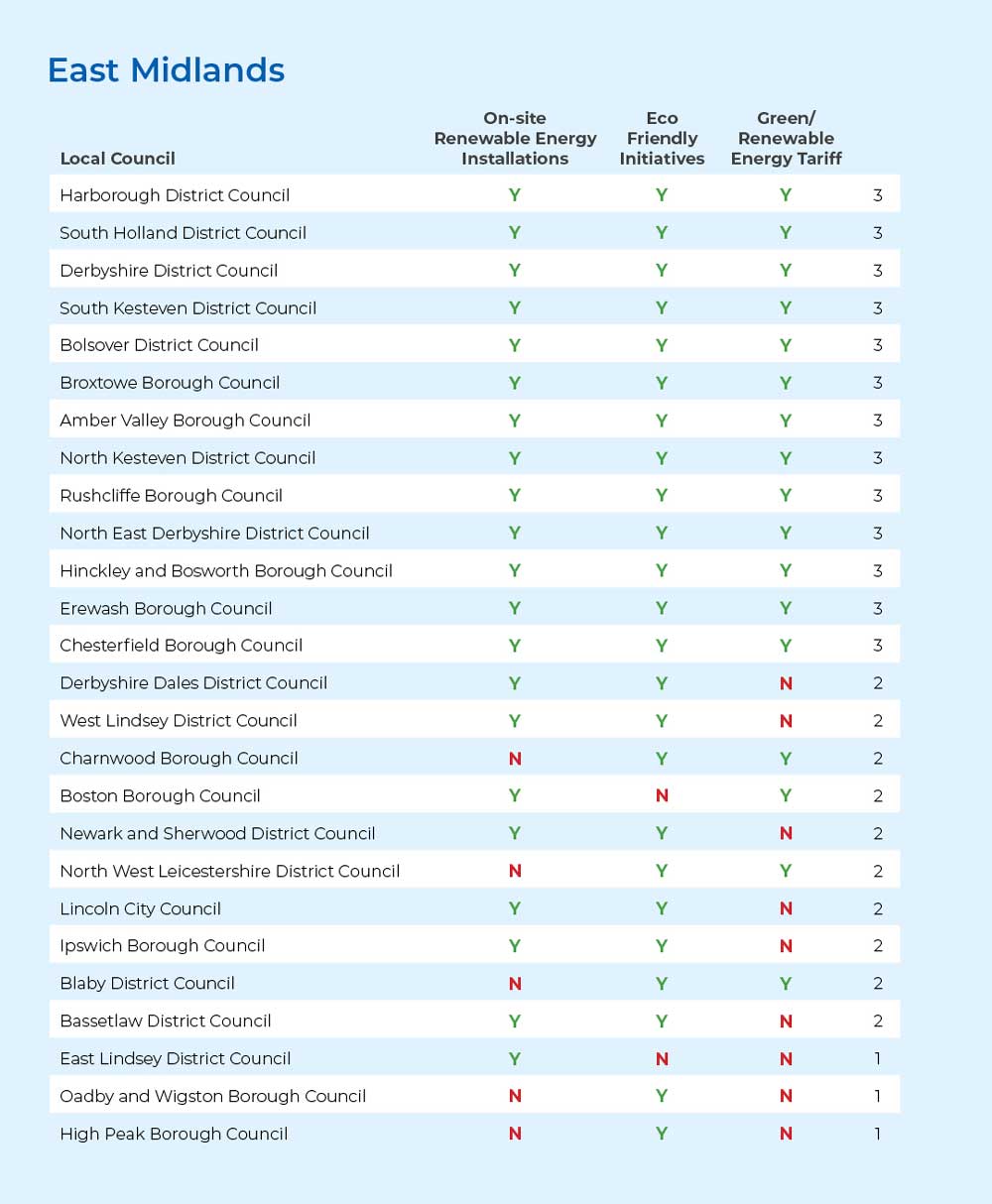
Of the 145 councils that responded, 26 were located in the East Midlands. Among these, 13 councils responded ‘positively’ to all three questions placing them in Tier 1, including Harborough District Council, Broxtowe Borough Council and Derbyshire District Council.
Chesterfield Borough Council was also included, with on-site renewable energy installations including Solar PV panels on two of their buildings, as well as being on a renewable energy tariff. They also run a wide range of eco-friendly activities and promotional opportunities including a salary sacrifice bicycle buying scheme, and a range of themed eco-friendly initiatives accessible throughout the year. These include recycling competitions, and the ‘Staff in Bloom’ competition which, according to the website, aims to make the town a “cleaner and greener place to live, work and visit.”
Making an appearance in Tier 2 are 10 councils, including Derbyshire Dales District Council, West Lindsey District Council and Lincoln City Council. While they all had renewable energy installations on-site and took part in eco-friendly staff initiatives, they were not on a renewable energy tariff.
East Lindsey District Council, Oadby and Wigston Borough Council and High Peak Borough Council were in Tier 3. Two of these did not use any renewable energy installations, and none were on renewable energy tariff.
There were no councils in the East Midlands reported in Tier 4.
Results in the East of England
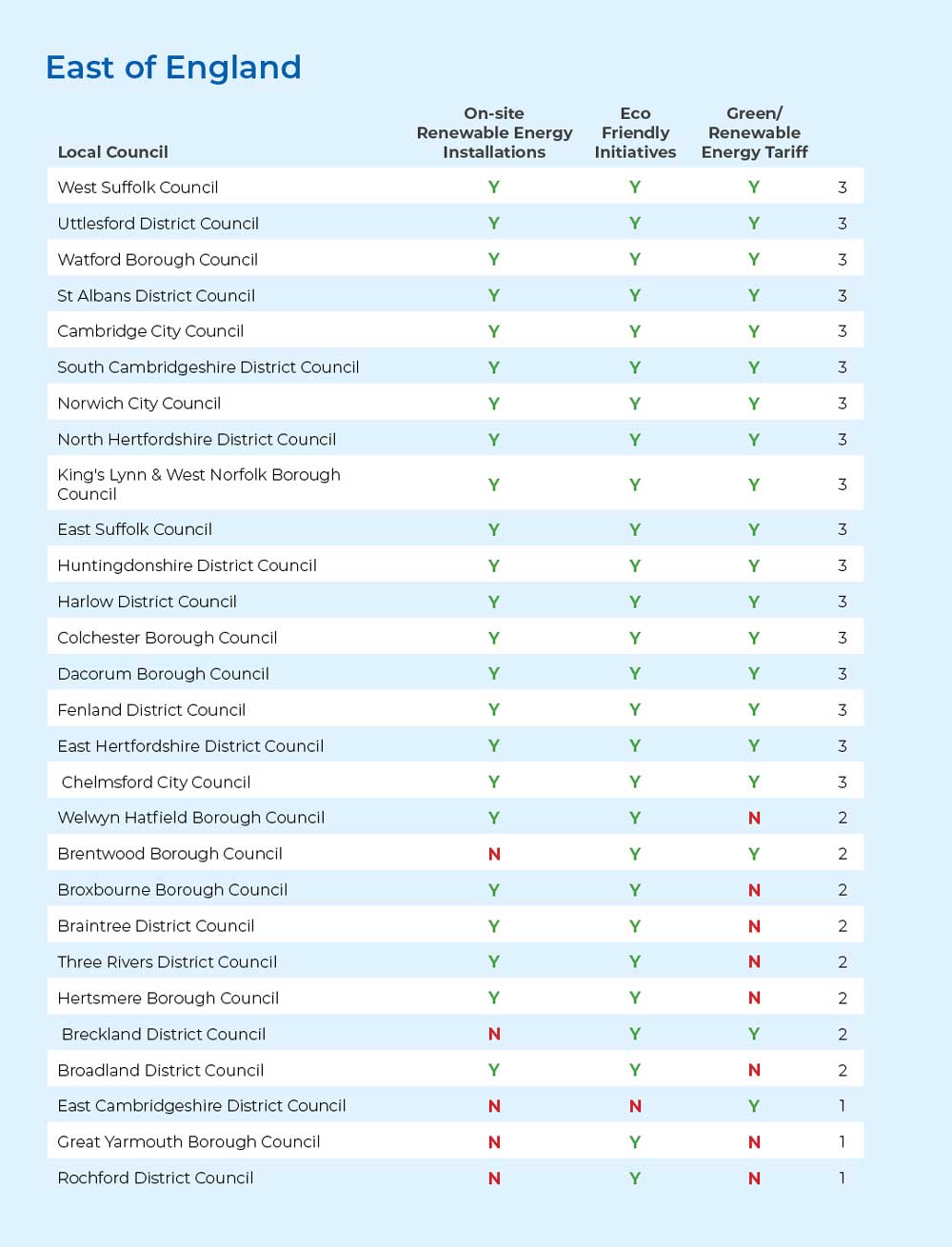
When it came to the East of England 28 responses were received from councils across the region, over half of which appear in Tier 1.
West Suffolk Council, Uttlesford District Council, Watford Borough Council and East Suffolk Council all said they have renewable energy installations at one or more of their council buildings, whilst promoting climate-friendly initiatives for staff to get involved with and were also all on a green energy tariff with their provider.
The Forum at Dacorum Borough Council has solar PV panels on its roof, and this generates the majority of the electricity that the building uses. Sustainable Clothes Swaps are also held throughout the year, in which staff are encouraged to take part, whilst the Love Food, Hate Waste challenge > is held annually with residents and staff encouraged to take part.
Welwyn Hatfield Borough Council, Broxbourne Borough Council, Braintree District Council and Three Rivers District Council all find themselves placed in Tier 2 because they were not on renewable energy tariffs. Brentwood Borough Council finds itself in the same position as a result of no renewable energy installations on-site. However, all councils in the East of England in this tier do provide eco-friendly initiatives for staff members.
In Tier 3, East Cambridgeshire District Council is the only council throughout the East of England not currently providing any initiatives for members of staff to take part in.
Results in North West England
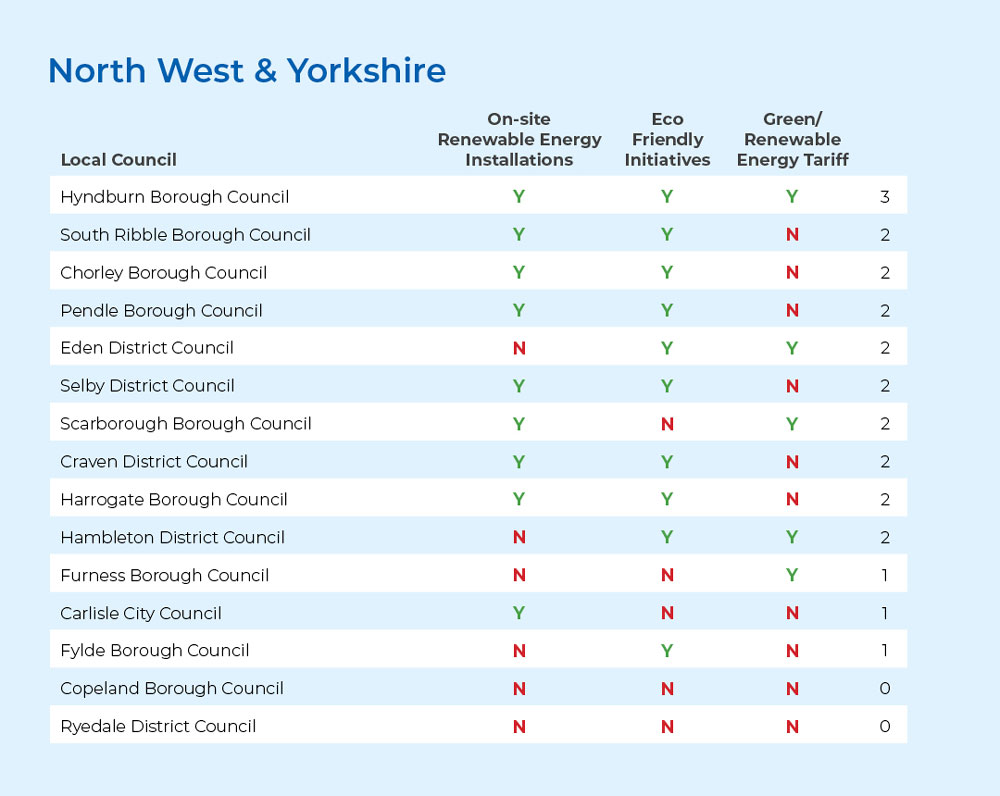
In North West England, Hyndburn Borough Council was the only council to achieve Tier 1 status. The renewable energy installation includes a storage tank, topped up periodically via a submersible pump, powered by a low voltage wind and solar system. The council has also introduced a bicycle mileage rate, encouraging people to cycle to work if they can, alongside providing electric bikes for staff members to use and full recycling systems within all the council-owned buildings.
Four councils find themselves in Tier 2. Whilst South Ribble Borough Council, Chorley Borough Council and Pendle Borough Council all offer initiatives for staff and do have renewable energy installations on-site, none were on a renewable energy tariff. On the other hand, Eden District Council have no on-site renewable installations.
In Tier 3, Carlisle City Council do not offer any eco-friendly staff initiatives nor were they on a renewable tariff.
Copeland Borough Council have been placed in Tier 4, with no renewable installations on-site, no eco-friendly initiatives for staff, and were not on a renewable energy tariff for any of their buildings.
Yorkshire & the Humber was the only region in our study without a top-scoring Tier 1 council, with the majority placed in Tier 2. Alongside Copeland, Ryedale District Council also placed in Tier 4.
Results in South East England
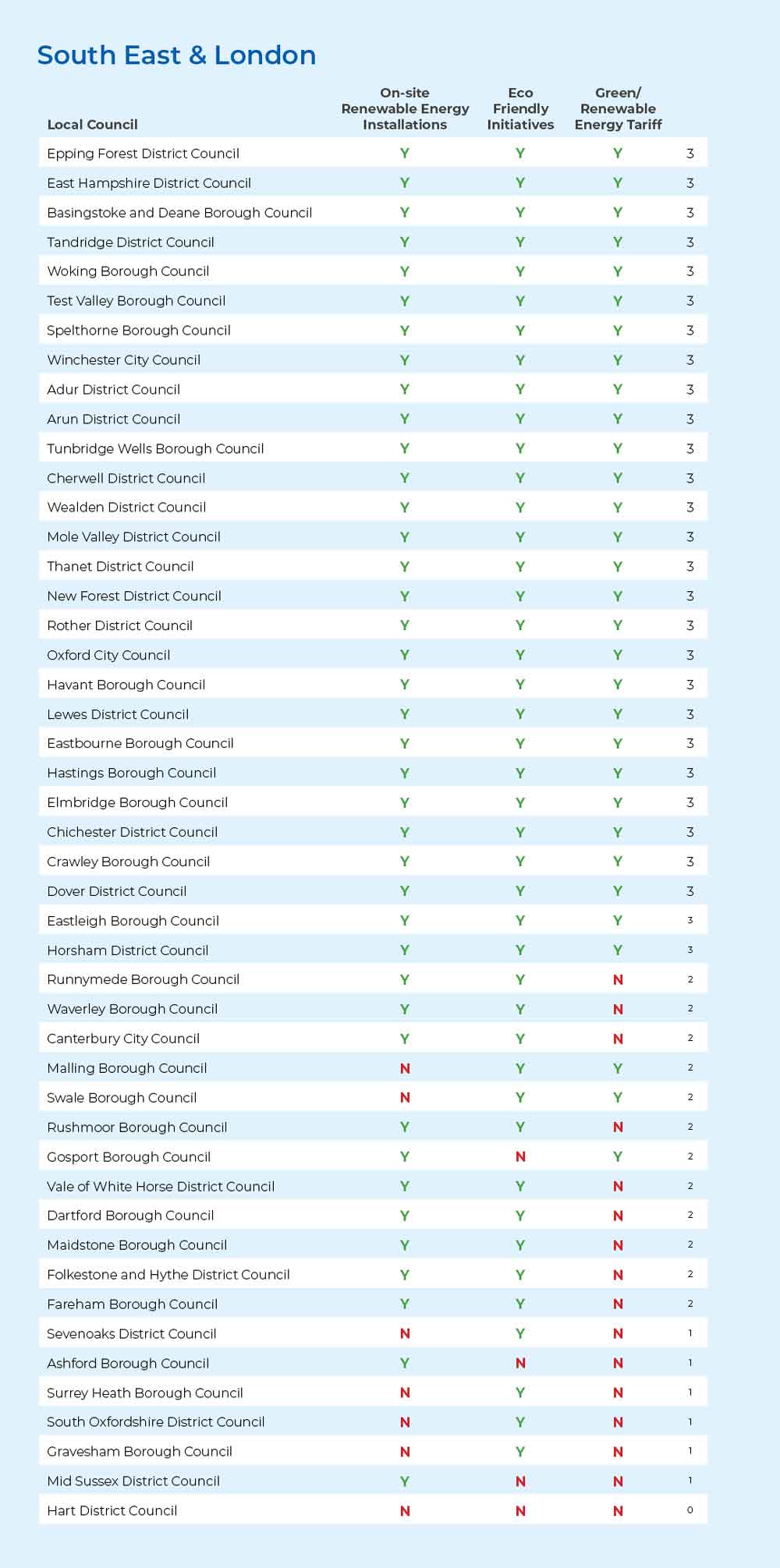
In South East England, 27 out of 46 councils appear in Tier 1, with councils such as East Hampshire District Council, Woking Borough Council and Oxford City Council all scoring across the board.
Adur District Council had one of the highest numbers of renewable energy installations across their buildings, with 8 operating on energy from Solar PV and another 2 sites utilising renewable heat installations.
The majority of councils in Tier 2 were scored as such due to not being on a renewable energy tariff with their energy providers. Others missed out on Tier 1 for a lack of eco-friendly staff initiatives.
Tier 3 includes Surrey Heath Borough Council, South Oxfordshire District Council and Gravesham Borough Council, all of which provide staff initiatives but were unable to answer positively when it came to the rest of the criteria.
In Tier 4, Hart District Council is the only council throughout South East England not currently partaking in any of the criteria in our study.
With just one response from a council in Greater London, Epping Forest District Council scored a full-house, placing it firmly in Tier 1.
Results in South West England
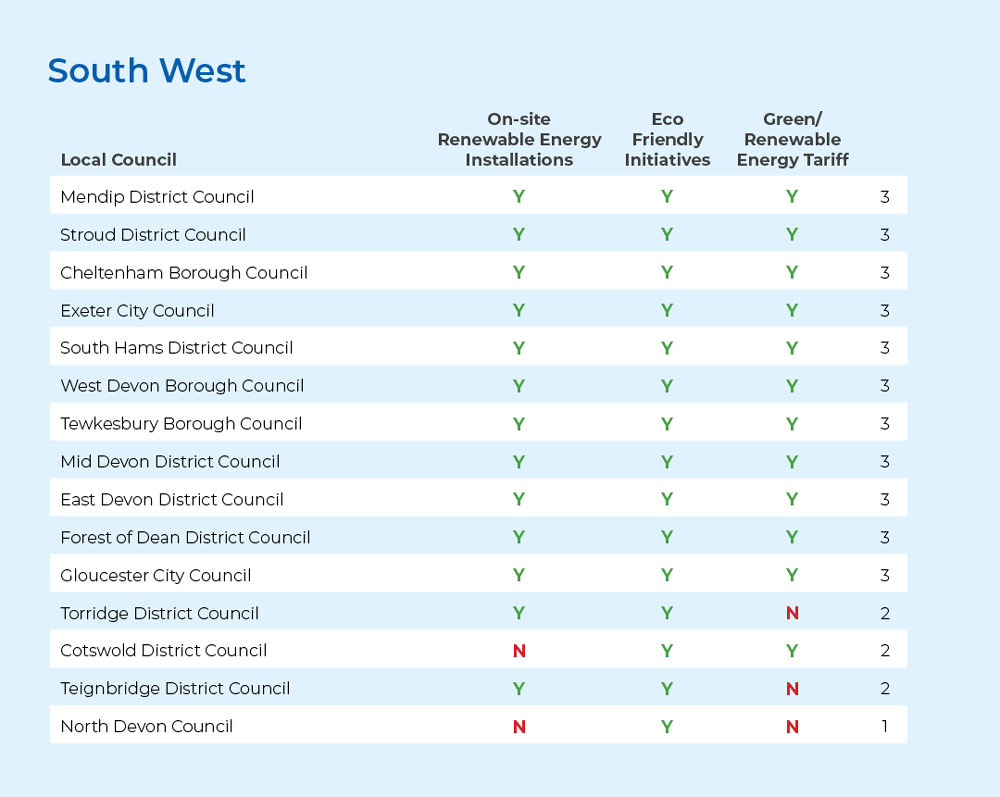
Among the Tier 1 scorers in South West England, Exeter City Council has over 2MW of installed
Solar PV across their buildings. They are also Net Zero Ambassadors and encourage staff to live sustainably by promoting a Green Travel Scheme as well as putting in place recycling initiatives in-house.
A recurring theme in our study is where councils are placed in Tier 2 because they are not on renewable tariffs with their energy providers, and this is true for Torridge District Council and Teignbridge District Council.
Finally, North Devon Council is the lowest-scoring council in South West England.
Results in the West Midlands
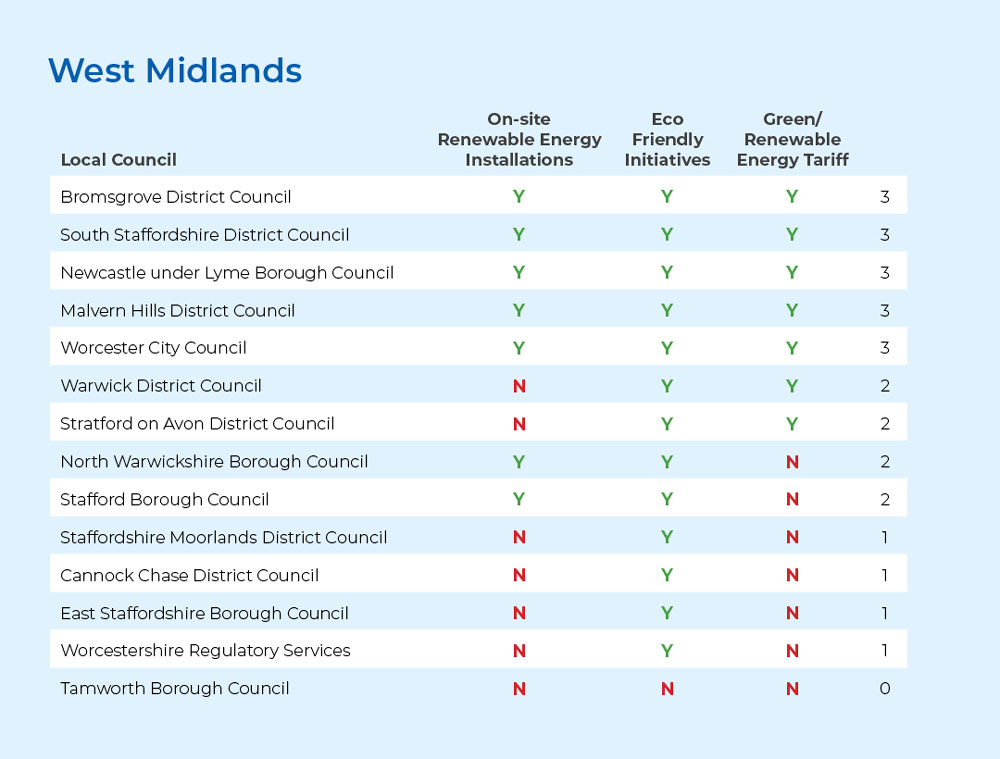
In Tier 1, the four councils that responded (Bromsgrove District Council, South Staffordshire District Council, Newcastle under Lyme Borough Council, Malvern Hills District Council and Worcester City Council) all have a renewable energy tariff, renewable schemes for staff and renewable installations on site.
Tamworth Borough Council were unable to respond positively to any of the questions.
Summary
In total across the study, 79% of council buildings are reportedly powered by renewable energy installations. However over a quarter (37%) of local councils stated that they are not on a renewable energy tariff with their supplier. Just 9% of councils surveyed do not currently provide any eco-friendly initiatives for staff members.